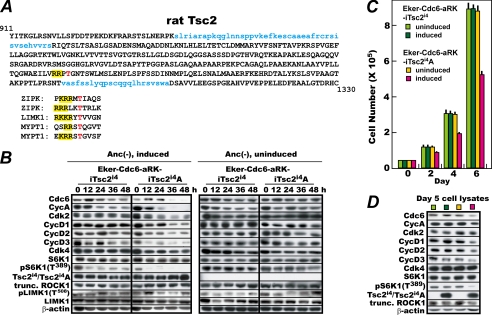FIGURE 6.
Expression of a mutant form of TSC2i4 (TSC2i4A) in which Thr1203 is substituted with alanine fails to restore susceptibility of Eker-Cdc6 cells to active ROCK1 in absence of anchorage. A, the presence of a ROCK phosphorylation consensus sequence in rat TSC2. Upper panel, the amino acids in blue are those encoded by exons 25 and 31. The T in red is the putative phosphorylation site, and the preceding basic amino acids (RR) are highlighted in yellow. Lower panel, the ROCK phosphorylation sites and surrounding amino acid sequences of ZIPK1, LIMK1, and MYPT1. B, logarithmically proliferating Eker-Cdc6-aRK-iTsc2i4 and Eker-Cdc6-aRK-iTsc2i4A cells were induced for TSC2i4 or TSC2i4A by withdrawal of doxycycline or were uninduced. Two days later, the cells were cultured in methylcellulose medium, and samples were harvested every 12 h for 48 h and analyzed for the indicated factors by immunoblotting. C, expression of TSC2i4A retards cell proliferation in culture dishes. Logarithmically proliferating Eker-Cdc6-aRK-iTsc2i4 and Eker-Cdc6-aRK-iTsc2i4A cells were induced for TSC2i4 or TSC2i4A by withdrawal of doxycycline or were uninduced, cultured for 2 days, then replated at 4 × 104 cells each on three 10-cm plates for each sampling time point, and further cultured with sampling every other day until day 6. The cells were counted, and average cell numbers with S.D. values were calculated from the data of the three plates. Light and dark green, uninduced and induced Eker-Cdc6-aRK-iTsc2i4 cells, respectively; orange and dark red, uninduced and induced Eker-Cdc6-aRK-iTsc2i4A cells, respectively. D, on day 5 in C, the cells were harvested and examined for the indicated factors by immunoblotting. The same coloring as in C is used. Anc, anchorage; Cyc, cyclin.

